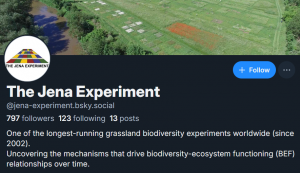New publication from Venjakob et al. in Plant Biology: Variation in nectar quality across 34 grassland plant species

Floral nectar is considered the most important floral reward for attracting pollinators. It contains large amounts of carbohydrates besides variable concentrations of amino acids and thus represents an important food source for many pollinators. Its nutrient content and composition can, however, strongly vary within and between plant species. The factors driving this variation in nectar quality are still largely unclear.
We investigated factors underlying interspecific variation in macronutrient composition of floral nectar in 34 different grassland plant species. Specifically, we tested for correlations between the phylogenetic relatedness and morphology of plants and the carbohydrate (C) and total amino acid (AA) composition and C:AA ratios of nectar.
We found that compositions of carbohydrates and (essential) amino acids as well as C:AA ratios in nectar varied significantly within and between plant species. They showed no clear phylogenetic signal. Moreover, variation in carbohydrate composition was related to family-specific structural characteristics and combinations of morphological traits. Plants with nectar-exposing flowers, bowl- or parabolic-shaped flowers, as often found in the Apiaceae and Asteraceae, had nectar with higher proportions of hexoses, indicating a selective pressure to decelerate evaporation by increasing nectar osmolality.
Our study suggests that variation in nectar nutrient composition is, among others, affected by family-specific combinations of morphological traits. However, even within species, variation in nectar quality is high. As nectar quality can strongly affect visitation patterns of pollinators and thus pollination success, this intra- and interspecific variation requires more studies to fully elucidate the underlying causes and the consequences for pollinator behaviour.
Reference:
Venjakob, C., Ruedenauer, F.A., Klein, A.-M. and Leonhardt, S.D. (2021), Variation in nectar quality across 34 grassland plant species. Plant Biol J. https://doi.org/10.1111/plb.13343



